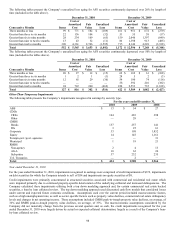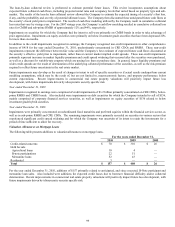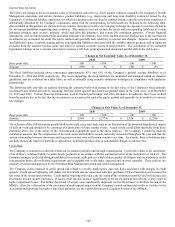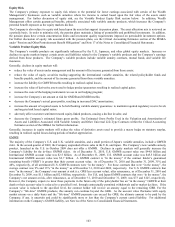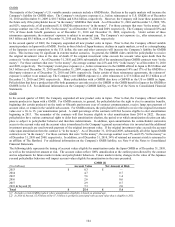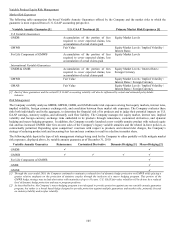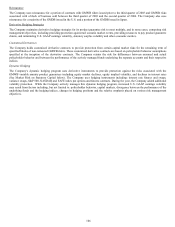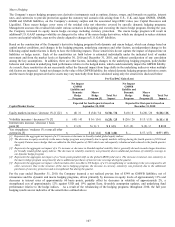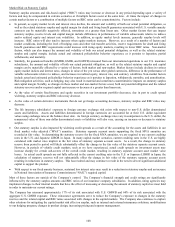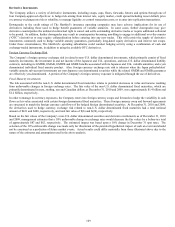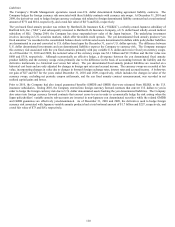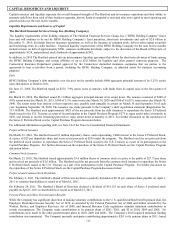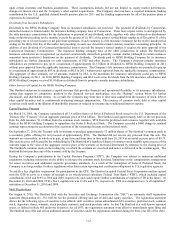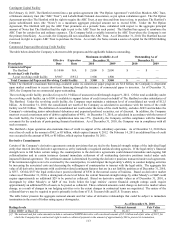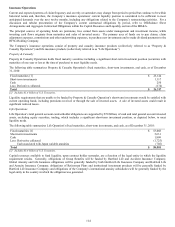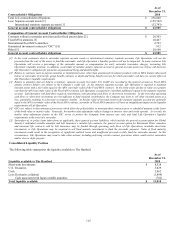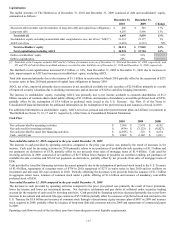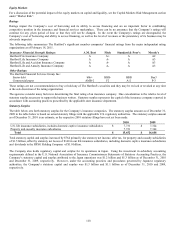The Hartford 2010 Annual Report Download - page 108
Download and view the complete annual report
Please find page 108 of the 2010 The Hartford annual report below. You can navigate through the pages in the report by either clicking on the pages listed below, or by using the keyword search tool below to find specific information within the annual report.
108
Market Risk on Statutory Capital
Statutory surplus amounts and risk-based capital (“RBC”) ratios may increase or decrease in any period depending upon a variety of
factors and may be compounded in extreme scenarios or if multiple factors occur at the same time. At times the impact of changes in
certain market factors or a combination of multiple factors on RBC ratios can be counterintuitive. Factors include:
• In general, as equity market levels and interest rates decline, the amount and volatility of both our actual potential obligation, as
well as the related statutory surplus and capital margin for death and living benefit guarantees associated with U.S. variable annuity
contracts can be materially negatively effected, sometimes at a greater than linear rate. Other market factors that can impact
statutory surplus, reserve levels and capital margin include differences in performance of variable subaccounts relative to indices
and/or realized equity and interest rate volatilities. In addition, as equity market levels increase, generally surplus levels will
increase. RBC ratios will also tend to increase when equity markets increase. However, as a result of a number of factors and
market conditions, including the level of hedging costs and other risk transfer activities, reserve requirements for death and living
benefit guarantees and RBC requirements could increase with rising equity markets, resulting in lower RBC ratios. Non-market
factors, which can also impact the amount and volatility of both our actual potential obligation, as well as the related statutory
surplus and capital margin, include actual and estimated policyholder behavior experience as it pertains to lapsation, partial
withdrawals, and mortality.
• Similarly, for guaranteed benefits (GMDB, GMIB, and GMWB) reinsured from our international operations to our U.S. insurance
subsidiaries, the amount and volatility of both our actual potential obligation, as well as the related statutory surplus and capital
margin can be materially affected by a variety of factors, both market and non-market. Market factors include declines in various
equity market indices and interest rates, changes in value of the yen versus other global currencies, difference in the performance of
variable subaccounts relative to indices, and increases in realized equity, interest rate, and currency volatilities. Non-market factors
include actual and estimated policyholder behavior experience as it pertains to lapsation, withdrawals, mortality, and annuitization.
Risk mitigation activities, such as hedging, may also result in material and sometimes counterintuitive impacts on statutory surplus
and capital margin. Notably, as changes in these market and non-market factors occur, both our potential obligation and the related
statutory reserves and/or required capital can increase or decrease at a greater than linear rate.
• As the value of certain fixed-income and equity securities in our investment portfolio decreases, due in part to credit spread
widening, statutory surplus and RBC ratios may decrease.
• As the value of certain derivative instruments that do not get hedge accounting decreases, statutory surplus and RBC ratios may
decrease.
• The life insurance subsidiaries’ exposure to foreign currency exchange risk exists with respect to non-U.S. dollar denominated
assets and liabilities. Assets and liabilities denominated in foreign currencies are accounted for at their U.S. dollar equivalent
values using exchange rates at the balance sheet date. As foreign currency exchange rates vary in comparison to the U.S. dollar, the
remeasured value of those non-dollar denominated assets or liabilities will also vary, causing an increase or decrease to statutory
surplus.
• Our statutory surplus is also impacted by widening credit spreads as a result of the accounting for the assets and liabilities in our
fixed market value adjusted (“MVA”) annuities. Statutory separate account assets supporting the fixed MVA annuities are
recorded at fair value. In determining the statutory reserve for the fixed MVA annuities, we are required to use current crediting
rates in the U.S. and Japanese LIBOR in Japan. In many capital market scenarios, current crediting rates in the U.S. are highly
correlated with market rates implicit in the fair value of statutory separate account assets. As a result, the change in statutory
reserve from period to period will likely substantially offset the change in the fair value of the statutory separate account assets.
However, in periods of volatile credit markets, such as we have experienced, actual credit spreads on investment assets may
increase sharply for certain sub-sectors of the overall credit market, resulting in statutory separate account asset market value
losses. As actual credit spreads are not fully reflected in the current crediting rates in the U.S. or Japanese LIBOR in Japan, the
calculation of statutory reserves will not substantially offset the change in fair value of the statutory separate account assets
resulting in reductions in statutory surplus. This has resulted and may continue to result in the need to devote significant additional
capital to support the product.
• With respect to our fixed annuity business, sustained low interest rates may result in a reduction in statutory surplus and an increase
in National Association of Insurance Commissioners (“NAIC”) required capital.
Most of these factors are outside of the Company’ s control. The Company’ s financial strength and credit ratings are significantly
influenced by the statutory surplus amounts and RBC ratios of our insurance company subsidiaries. In addition, rating agencies may
implement changes to their internal models that have the effect of increasing or decreasing the amount of statutory capital we must hold
in order to maintain our current ratings.
The Company has reinsured approximately 17% of its risk associated with U.S. GMWB and 60% of its risk associated with the
aggregate U.S. GMDB exposure. These reinsurance agreements serve to reduce the Company’ s exposure to changes in the statutory
reserves and the related capital and RBC ratios associated with changes in the capital markets. The Company also continues to explore
other solutions for mitigating the capital market risk effect on surplus, such as internal and external reinsurance solutions, modifications
to our hedging program, changes in product design, increasing pricing and expense management.


